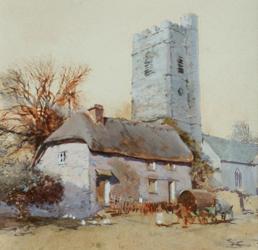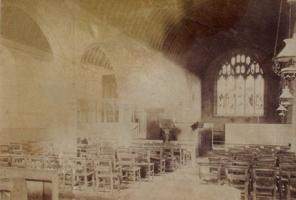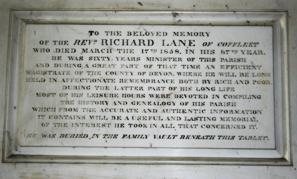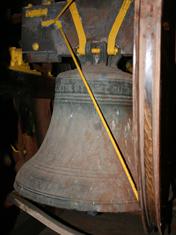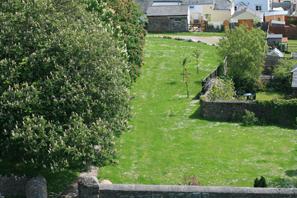St Mary's Church - The History
|
Gouache painting, by J. B. King, of St. Mary's Church |
Early HistoryBrixton was, anciently, in the Hundred of Plympton. In 1086, the year of Domesday, nearly the entire Hundred, including Brixton, was under the parochial charge of the priests of St. Mary & St. Paul at Plympton. This preconquest Saxon Chapel and College had a Dean or Provost and other priests and was a Royal foundation. It is likely that in these remote times, Mass would have been said in the village of Brixton around a granite cross, (such as those at Elburton and Plympton St. Maurice), or, possibly, centered on the domestic chapel of the Norman family of de Britrickstone, from whom the village derives its name. In 1121 Plympton ceased to be a college and William, Bishop of Exeter, established an Augustinian Priory in its stead. The Priory was the Mother Church of Brixton, and the spiritual needs of the village the responsibility of the Prior, and through him, his visiting priests. As a dependent chapelry Brixton probably, then, justified a small building on the site of our present Church. |
|
This early photo hints at lost glories.. |
Present ChurchThere seems good reason to believe that our Chancel contains the remains of this earlier Church. St. Mary's as it now exists, however, dates from the second half of the 15th century. It is perpendicular in style and typical of many similar West Country churches which were rebuilt or enlarged about that time. It is of interest that Brixton was not advanced to the full position of a Parochial Church, with burial rights, until 18th April 1477. Before this the villagers were obliged to carry their dead to Plympton for burial. It is sad that dilapidations and subsequent restorations in 1887 and 1894 have destroyed for all time many early features of great beauty and interest, including 16th century stained armorial glass, mediaeval roof bosses, bench ends and the ornamental rood screen and roof loft. There were originally two chapels within the Church: the Hareston to the N.E. and the Spriddleston to the S.E. These were associated, respectively, with the Wood and Fortescue families who owned these Domesday Manors for very many generations. Spriddleston no longer exists, but Hareston has survived. The hagioscope or squint at the N.E. is original, but the one to the S.E. is a modern insertion. There is a late 15th century window in the modern vestry which originally came from the Fortescue manor of Spriddlestone. North of the Church is a late mediaeval house, the former parsonage or Church House. |
|
Memorial to the Reverend Lane |
MemorialsMost of the memorial tablets in the Church are to members of the lane family who resided at Cofflett (Cofflete), within the parish. The Revd. Richard Lane was Vicar for 60 years and died in 1858. He wrote a scholarly history of the district which is still preserved in the parish records. There is an early 18th century memorial slab to the Wood family in the Hareston Chapel, depicting the armorial bearings of this family. |
|
As seen from a climb up the steep steps of the tower.. |
BellsThere are five bells all bearing the date 1737. 1st bell (5 cwts.) 'When you ring us sweetly sing'. 2nd bell (6 cwts.) 'Prosperity to the Church of England'. 3rd bell (7 cwts.) 'Unto the Church the living call.Unto the grave I summon all.' 4th bell (9 cwts.) 'We were all cast at Gloucester by Abel Rudhall.' 5th bell 'Robert Avent - Church Warden' A 6th bell was added (treble) in 1934 and they are all rung regularly. |
PlateThe communion plate includes a 16th century silver chalice by Ions of Exeter ( John Jones, a goldsmith resident in and churchwarden of St. Petrock's Exeter), a noted West Country silversmith who made much plate for Devon churches. |
|
RegistersThese date from 1668 and are notable for the perpetuation of many family names over the centuries, many still present in the parish. Legend has it that the Church was used by the victorious Roundhead forces as a stable after the battle of Modbury in 1642, and it seems probable that earlier registers were destroyed at that time. |
|
|
The Park |
ChurchyardThe original churchyard has been extended many times. Beyond the eastern extremity of the churchyard is the Park which is part of the Brixton Feoffee Trust dating from 1483. In addition a row of trees first planted in 1677 by Edward Fortescue of Spriddlestone, to be felled for the relief of the poor. |
Your prayers
Please remember our Church in your prayers, in thanksgiving for its long history, and for the many people who make up the Church and its life today. This is not just an ancient monument but the living centre of a Parish where all can return for guidance and strength to carry out our Lord's will in whatever way they are able.
These notes were prepared by the late Mr. K Bassett.
A feature of the Choir Stalls is this exquisite series of carved angels.
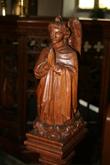 |
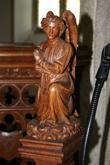 |
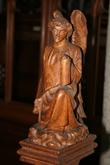 |
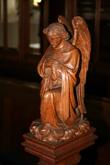 |
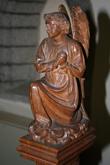 |
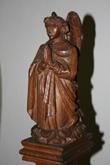 |
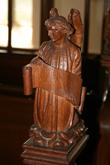 |
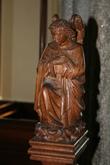 |
 The High Altar |
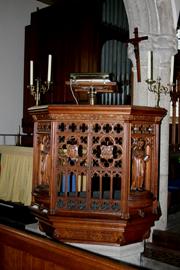 The Pulpit |

